If you're looking for an authentic, delicious vegan Thai yellow curry with tofu recipe, then you're in the right place! You can make your own curry paste that's loaded up with fragrant ingredients and aromatics, or use a store bought one. Either way, we're sure this vegetarian yellow curry with its amazing sauce that's loaded with tofu, potatoes and vegetables will hit the spot!
Jump to:
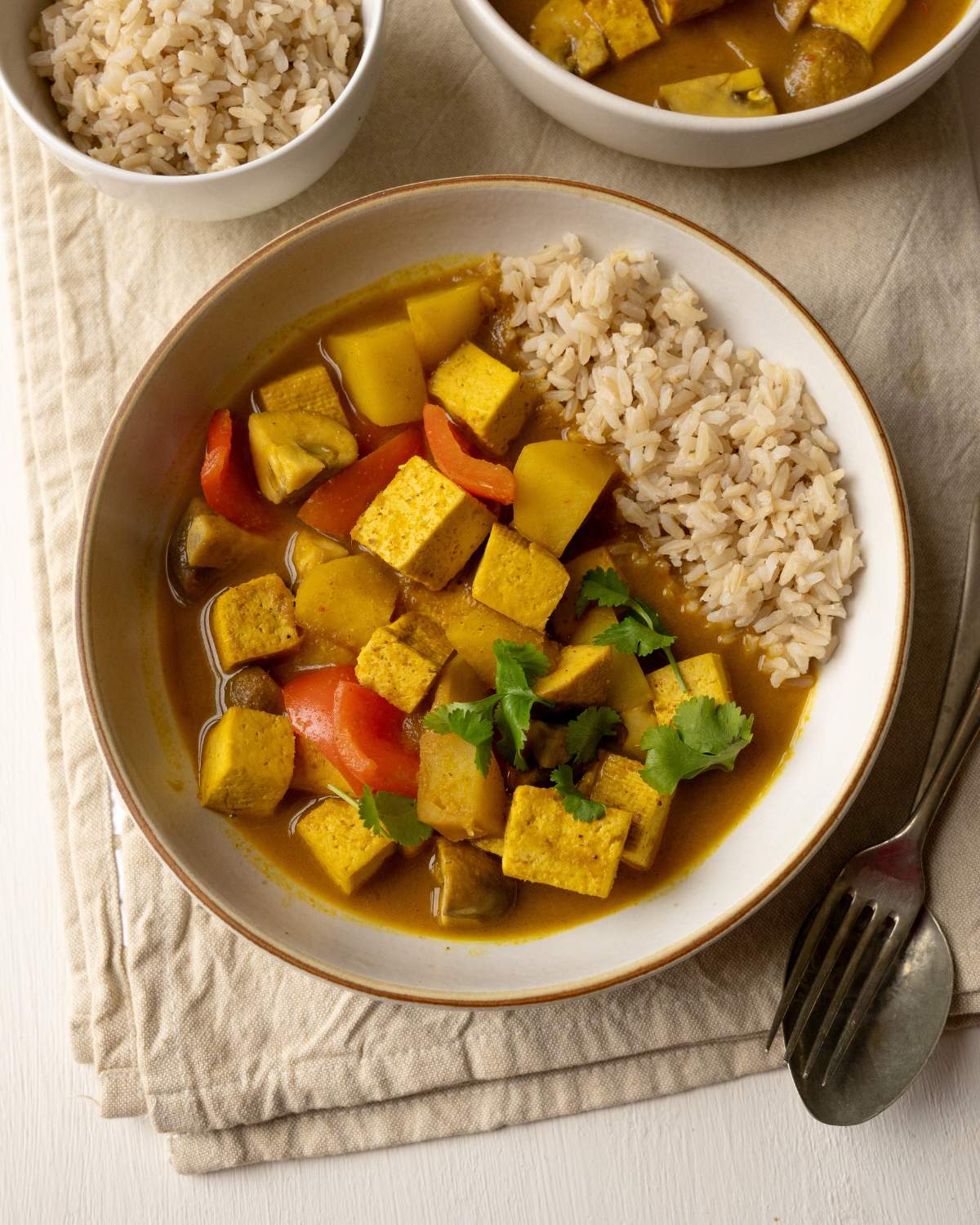
🌟 Why this recipe works
We know Thai food - we've travelled in Thailand extensively and have taken part in plenty of cooking classes while there (as well as eating Thai food non-stop), so you're in safe hands. So we know all about balancing the 5 Thai flavor profiles - salty, sweet, sour, spicy and creamy. Sometimes this is known as the 4 Thai flavor profiles, which doesn't incorporate 'creamy', which is how we first learnt about them.
This yellow curry with tofu recipe calls for vegan fish sauce (or soy sauce) for saltiness, brown sugar for sweetness, tamarind paste for sourness, dried chillies for spiciness and coconut milk for creaminess.
Authentic flavors - this Thai tofu yellow curry packs in all the authentic flavors, but it's completely vegan. Thai curries are some of the most fragrant in the world and are bursting with flavor - and this recipe is no different. As Thai curry recipes go, this is really one of the best.
Versatile - while we've selected tofu, potatoes, red bell peppers and mushrooms for this curry, you don't have to pick those! Thai curries are really versatile. That means you can add a whole variety of vegetables and protein options to them. Green beans, sweet potatoes, baby corn and a whole host of other options are delicious in this vegan yellow curry.
🤔 What is Thai yellow curry?
In the world of Thai cuisine, Thai yellow curry, also known as "Gaeng Gari" or "Kaeng Kari," is a delightful treasure that's earned its place on the global culinary stage. It has a fascinating history rooted in the influences of Indian and Malay traders who brought their spices to Thailand centuries ago. Thai chefs have skillfully adapted these flavors to create a unique and unforgettable culinary experience, to make it into a traditional Thai curry.
Its distinct taste profile is characterized by warm, earthy notes from turmeric, which lends a vibrant yellow hue to the dish. Complementing the turmeric are the aromatic nuances of coriander and cumin. However, what truly sets Thai yellow curry apart is its luxurious creaminess, thanks to the generous use of coconut milk. This adds a slightly sweet undertone, creating a harmonious balance of flavors.
When comparing Thai tofu yellow curry to its Thai curry counterparts, it's clear that each has its own distinct personality. Thai red curry, for instance, is fiery and intense, thanks to the use of red chilies, making it a spicy adventure for the taste buds. Green curry, on the other hand, is vibrant and herbaceous, incorporating ingredients like green chilies and kaffir lime leaves for a unique flavor profile. Massaman curry, which is another Thai-Malay dish with Indian influences, offers a sweet and nutty experience, featuring elements like peanuts and tamarind paste.
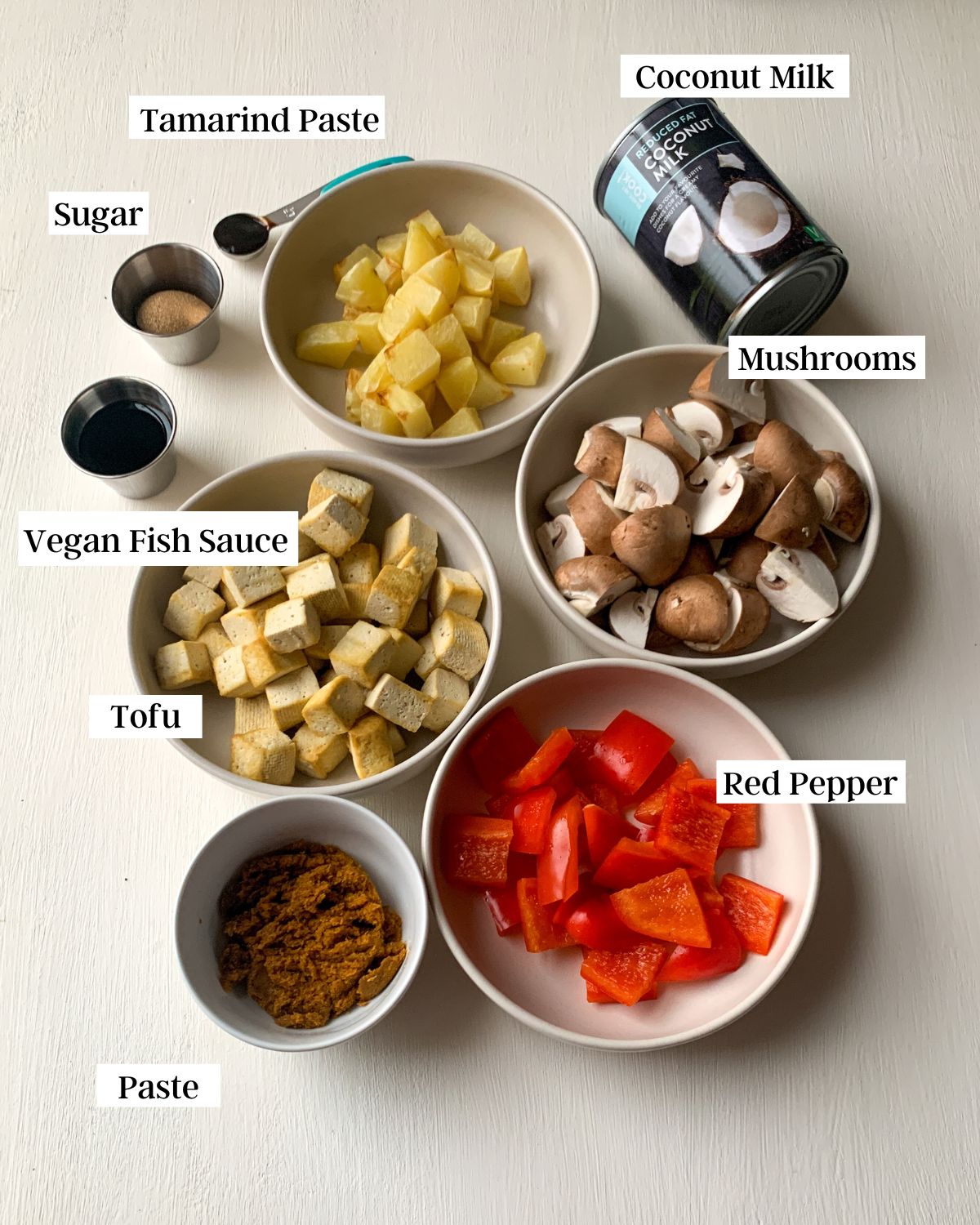
📋 Ingredient notes
Vegetables - Thai tofu yellow curry works well with all kinds of vegetables so feel free to use your favorites or whatever is left in the fridge. Potatoes and peppers are a classic choice and we think they go brilliantly in a yellow curry sauce, so we included them in this yellow curry recipe. And we just love mushrooms, so we added them and they go well too.
Vegan fish sauce - vegan fish sauce is a condiment that's made to replicate fish sauce. It uses ingredients like seaweed and salt to give it that same kind of fishy, salty flavor but without the fish! We find it on supermarket shelves often but it can also be found online. However, it can easily be switched for light soy sauce.
Our experience is that it's often quite a bit saltier than light soy sauce, which is why we suggest using 1 tablespoon of it in this recipe (and adding more if needed). Go straight in with 2 tablespoons of light soy sauce if that's what you're using.
And if you ever come across a recipe that needs this fishy ingredient, we've got plenty of suggestions for the best fish sauce substitutes.
Tamarind paste - this is a sour paste with a slightly sweet edge that's made from the seed pods of the tamarind tree. We love the sour flavor that it adds to dishes like vegan pad Thai and jackfruit rendang.
It's another ingredient that's commonly stocked in supermarkets, but if we're being picky, keep an eye out for one with 60%+ (ideally even 90%+) tamarind content in the ingredients. There are a lot of poor quality options in the shops that can be too acidic, too sweet, or both. However, any option you can find would be better than an alternative like lime juice (but that is also fine if it's what you have).
Coconut milk - this creamy coconut milk addition is key for making the tofu yellow curry sauce. Full fat canned coconut milk or light coconut milk can be used. Full fat makes the yellow curry recipe creamier but light coconut milk will also work well.
Tofu - we recommend extra firm tofu for this vegan yellow curry recipe. That means you won't have to press it before cooking, so it saves a lot of time. Vegan tofu curry is up there with some of the best meals if you ask me, so we recommend cooking vegan yellow curry with it.
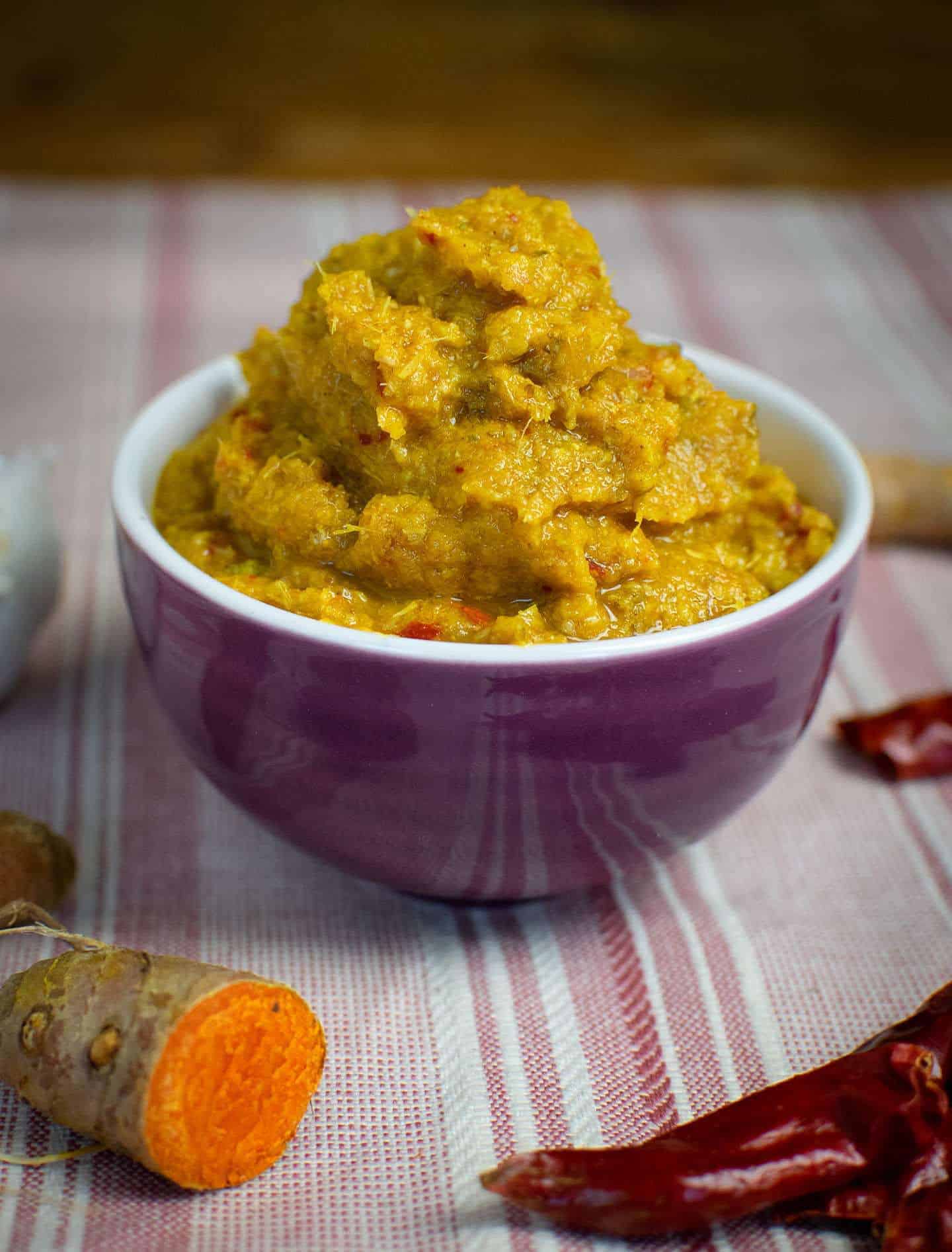
👩🍳 How to make yellow curry paste
Making your own curry paste is pretty easy if you can get your hands on the right ingredients! Thai yellow curry paste often includes a few ingredients that you might not have in your cupboard, which we'll cover a bit about below and there are also suggested substitutions even further down the article, so don't fret if you don't have something or you just don't want to go buy extra stuff.
There are two ways to create yellow curry paste. That's with a blender or a pestle and mortar. Pestle and mortar is the traditional approach and is more work but it's pretty satisfying to pound at the ingredients until they break down and create a delicious, fragrant paste. We'd recommend trying it at least once!
However, blending is much easier and quicker. Throw all the ingredients in a blender cup and add a couple of tablespoons of water - there always needs to be more liquid when blending otherwise you'll just burn out your blender. If it's still struggling to blend, add a little bit more water until it's loose enough. This goes for other pastes, such as green curry paste or red too.
Paste Ingredient Notes
Fresh turmeric - turmeric is part of the ginger family and looks fairly similar at a quick glance, as it grows in roots and has a similar brown skin. But the inside is a vibrant orange color.
The taste is also different to ginger. Instead of the fresh, fiery flavors of ginger, turmeric has more of an earthy, bitter flavor. You've probably cooked with ground turmeric, which is just turmeric root that's been dried and finely ground.
Turmeric is where yellow curry gets its color from, so it's a crucial ingredient. But, you could use ground turmeric if you can't find fresh.
Yellow bean paste - this is a fermented paste or sauce made from yellow soy beans. It has a really rich, complex flavor that's a bit salty and pungent. The reason that we've included it in our recipe for yellow curry paste is it makes a fairly good substitute for shrimp paste. There are plenty of other great shrimp paste substitutes you could use instead, or just omit it altogether.
Dried chilies - dried chilies are another staple ingredient in Thai cooking, especially for making curry pastes. This is no exception when making a yellow curry paste. They're a very affordable ingredient and keep for a while in the cupboard, so it's not a bad idea to buy a big bag and experiment with using them! It's the big kind of dried chilies that are used, so they don't add a huge amount of heat.
🔪 Vegan Thai yellow curry step-by-step instructions
This is a step-by-step overview with photos for making Thai yellow curry with tofu. The full recipe, along with measurements and detailed instructions can be found in the recipe card at the bottom of the page.
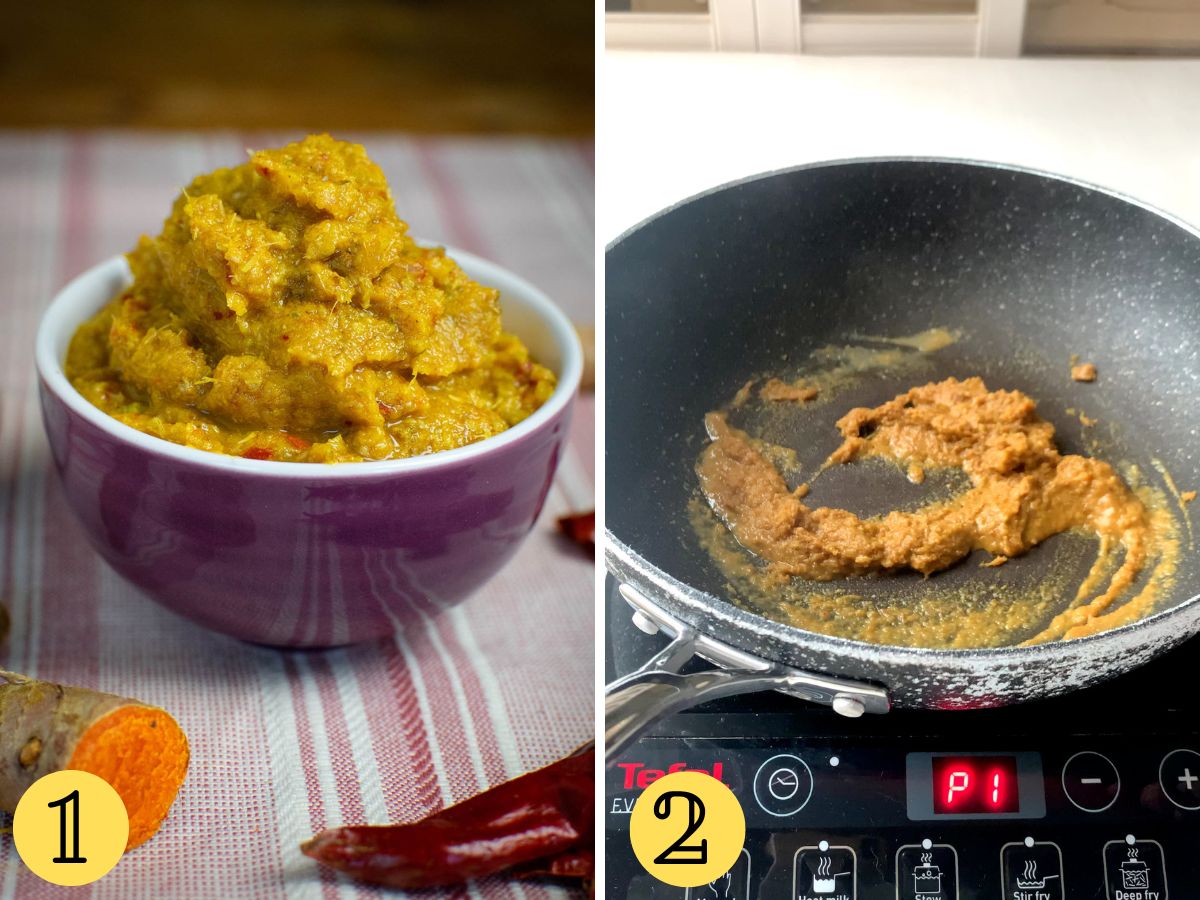
1. Pop all of the paste ingredients in a blender (or pestle and mortar) and blitz or bash until smooth. If using a blender, add 1-2 tablespoons of water to help the ingredients blend. You can use the water that the dried chillies were soaking in for extra flavour.
2. Pour the full amount of the paste into a wok over a medium-high heat. You can optionally add a splash of oil if needed.
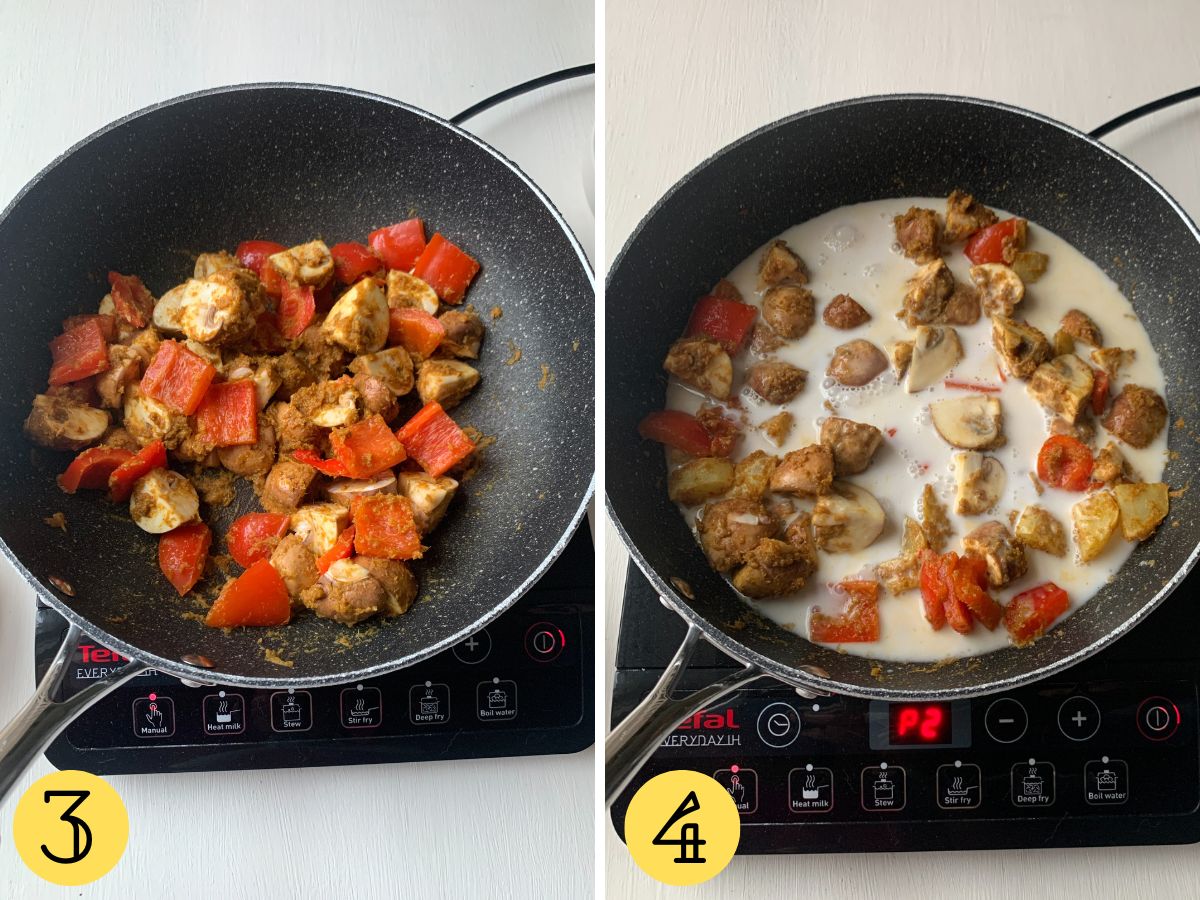
3. Once fragrant, add in the potatoes, mushrooms and pepper. Give it a good stir to make sure everything gets coated with the paste.
4. Pour in the coconut milk and water, stir and bring up to a simmer.
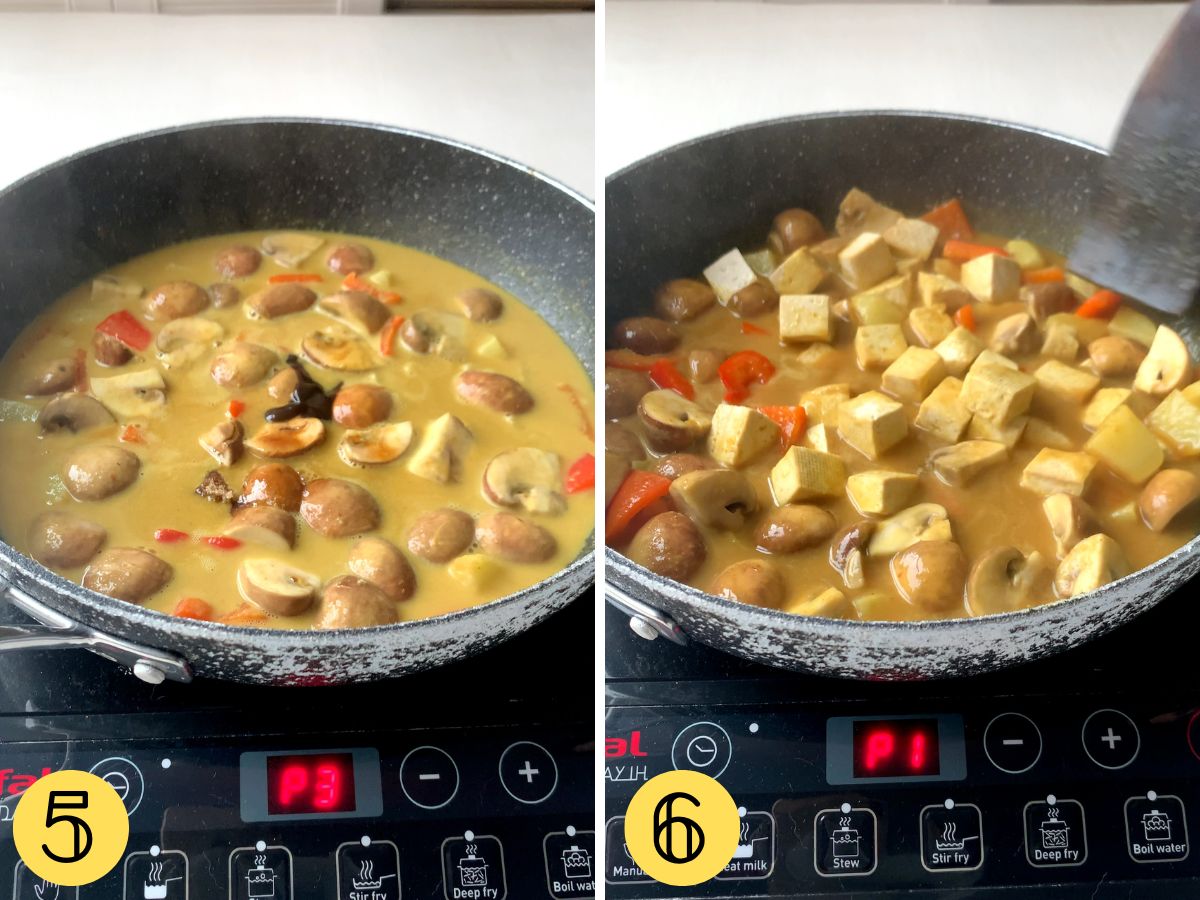
5. Pop in the sugar, tamarind, vegan fish sauce (or soy sauce) and stir.
6. Add in the tofu and then simmer for 10-12 minutes, until the potato is cooked.
7. Serve with Jasmine rice or brown rice, top with fresh cilantro and red chili pepper flakes (optional) and enjoy!
🧑🍳 Expert tips
Use a shop bought paste - while we've included a recipe to make yellow curry paste, not everyone wants to make their own paste. That's why we're never against using a shop bought curry paste, in fact, it's something we often do as well!
When selecting your yellow curry paste, just be careful that it doesn't include shrimp paste - this is the most common ingredient, and what makes Thai curry paste non-vegan. And we always recommend finding your closest oriental supermarket and seeing what they have on offer. They always have the best ingredients and often they have vegan products too, especially with the growing vegan movement. We recommend this vegan yellow curry paste.
Wear gloves - we recommend wearing gloves to handle fresh turmeric as it very easily stains skin (and anything else for that matter!). Turmeric is an amazing natural food dye so be very careful about what you get it on!
Fresh turmeric isn't the easiest ingredient to source but can be found in some main stream supermarkets. However, check out your local oriental supermarket as they probably stock it! Alternatively, you could use turmeric powder.
Gluten free - if you want to make this yellow curry with tofu gluten free then there's a couple of ingredient switches that might need to be made:
- Yellow bean paste - the fermented bean paste that is used to make the yellow curry paste sometimes uses wheat as a thickener. Find a gluten free alternative or use miso paste, which is usually gluten free.
- Soy sauce - so we suggest using vegan fish sauce, which is usually gluten free, but soy sauce is a more popular condiment to have in the cupboard. As soy sauce is not gluten free, you can use an alternative like tamari or liquid aminos (check out this guide for all the best light soy sauce substitutes).
Storage - this tofu yellow curry curry keeps well in the fridge for up to 3 days in an airtight container, or in the freezer for up to 3 months. Make sure to reheat thoroughly, and defrost before heating if frozen.
The yellow curry paste can be made in bulk and frozen too, which is a great tip so you don't have to make it regularly. The paste can be frozen in ice cube trays. Once frozen the cubes can be popped out and put into a tub or sealable bag and left in the freezer until needed. They can be thrown in a pan straight from frozen, which allows them to melt and then fry.
🥕 Substitutions
If you're missing any of the ingredients, you're allergic or you just don't fancy something, here are some ingredient substitution suggestions.
Coconut milk - light coconut milk or full fat coconut milk both work really well in this recipe. Obviously full fat coconut milk will make the yellow curry sauce a bit creamier, but we often cook our dishes with light coconut milk and they're always just as delicious.
Vegan fish sauce - switch it out for light soy sauce or tamari (for gluten free), but add 2 tablespoons instead of one.
Turmeric - fresh turmeric is integral for a yellow curry recipe. However, it can be switched for ground turmeric (a.k.a. turmeric powder). Use the same amount.
Tamarind - if you can't find tamarind paste then add a little squeeze of fresh lime juice for sourness, yellow tofu curry benefits from the sour flavor, so that the overall dish can be perfectly balanced.
Potatoes - you could alternatively try adding sweet potato to this tofu yellow curry. Traditionally white potatoes are used but sweet potato works well too!
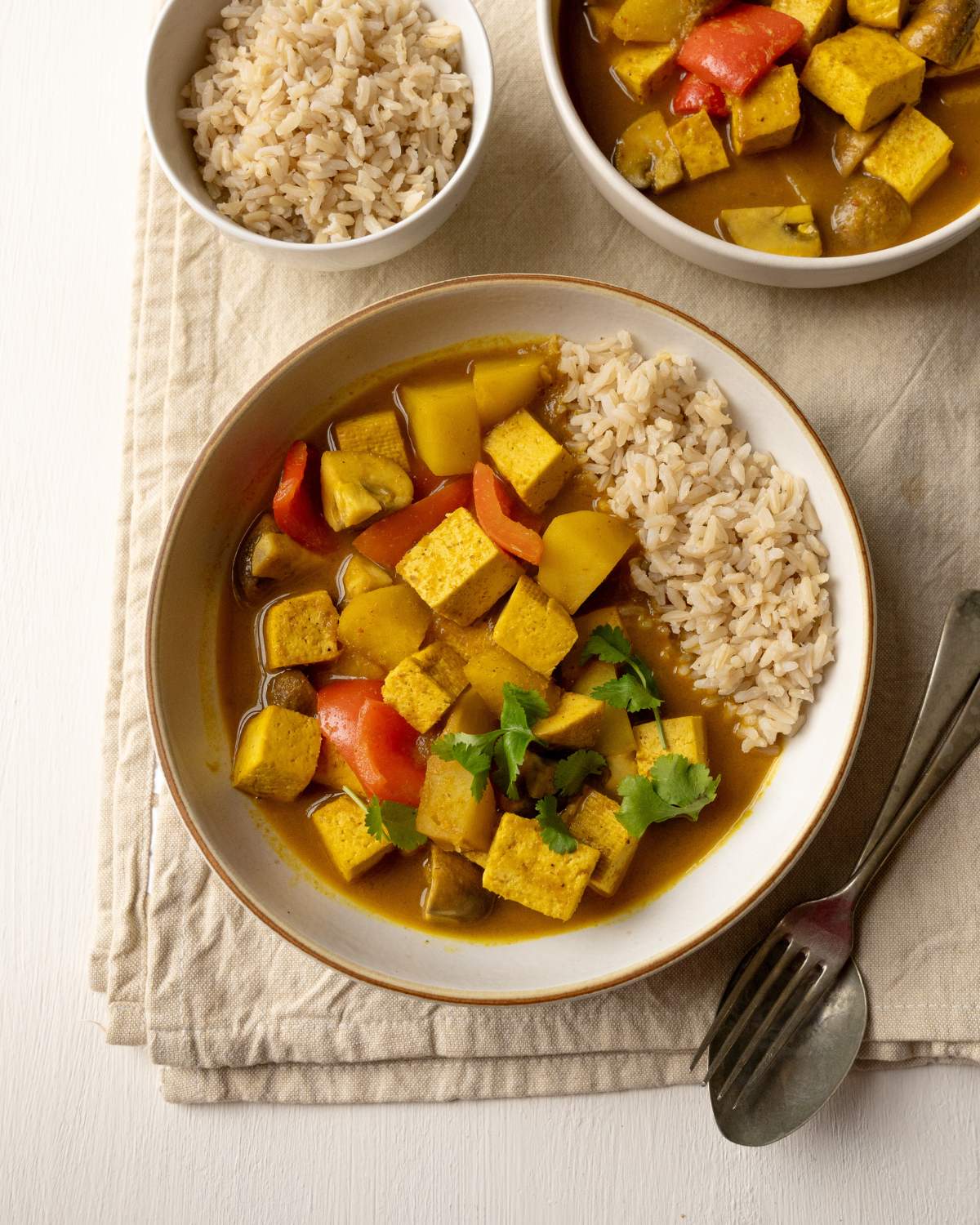
💭 FAQs
The unique flavor profile of Thai yellow curry is defined by the warm and earthy notes derived from turmeric, which imparts a vivid yellow tint to the dish. Alongside the turmeric, you'll discover the aromatic subtleties of coriander and cumin. Yet, what truly distinguishes Thai yellow curry is its creaminess, owing to the abundant inclusion of coconut milk. This infusion adds a touch of gentle sweetness, resulting in a delightful harmony of flavors.
As far as Thai curries go, Thai yellow curry is the mildest of the three, with red being the next hottest and then Thai green curry is the hottest of the bunch. Red and green curries both get their colours (and their names) from the colour of the chilli used in the paste, whereas yellow curry gets its colour from turmeric.
A Thai yellow curry, even if it's with tofu and vegetables, isn't necessarily vegan (or even vegetarian) as it is often made with non-vegan ingredients (such as shrimp paste). However vegan Thai yellow curry is easy to make (follow the recipe below) or if out in a restaurant, just check with the server.
🍛 Serving suggestions
Jasmine rice is the classic side to go with a yellow curry, but we're big fans of brown rice too. Alternatively you could use noodles, like a flat rice noodle. And if you're looking for sides, check out these amazing [Thai vegetable side dishes].
Jasmine rice or brown rice
Mango sticky rice for dessert
🇹🇭 More Thai recipes to try
We're pretty experienced in Thai cooking, so if you love vegan Thai food, here's some of our favourite recipes:
Did you make this recipe? Leave a review and a rating below, or tag us in your photos on Instagram! Alternatively, bookmark it in your browser or save to Pinterest for later.
If you love our content, please consider supporting it by buying us a coffee.
📖 Recipe
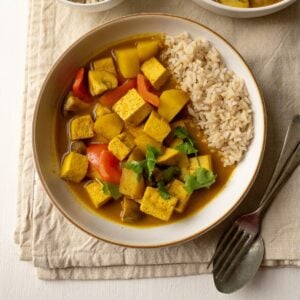
Thai Tofu Yellow Curry
Ingredients
For the homemade yellow curry paste:
- 2 shallots
- 5 cloves garlic
- 2 tablespoon lemongrass
- 0.5 tablespoon fresh ginger - peeled
- 5 dried red chillies soaked in warm water for 1 hour at least, or overnight
- 0.5 tablespoon fresh turmeric
- 1 teaspoon yellow bean paste or white miso paste
- 1 teaspoon salt
- 1 tablespoon coriander seeds
- 1 teaspoon cumin seeds
- 2 teaspoon curry powder
For the full curry:
- Yellow curry paste from above
- 250 g mushrooms – chopped
- 200 g potatoes – peeled and chopped
- 250 g extra firm tofu – pressed and chopped
- 1 red pepper – chopped
- 400 ml coconut milk
- 100 ml water
- 1 tablespoon brown sugar
- 1 teaspoon tamarind
- 1 tablespoon vegan fish sauce - or 2 tablespoon soy sauce
Instructions
For the yellow curry paste:
- Pop all of the paste ingredients in a blender (or pestle and mortar) and blitz or bash until smooth. If using a blender, add 1-2 tablespoon of water to help the ingredients blend. You can use the water that the dried chillies were soaking in for extra flavour.2 shallots, 5 cloves garlic, 2 tablespoon lemongrass, 0.5 tablespoon fresh ginger, 5 dried red chillies, 0.5 tablespoon fresh turmeric, 1 teaspoon yellow bean paste, 1 teaspoon salt, 1 tablespoon coriander seeds, 1 teaspoon cumin seeds, 2 teaspoon curry powder
For the curry:
- Pour the full amount of the paste into a wok over a medium heat. If non-stick you don't need oil. You can optionally add a splash of oil if needed.Yellow curry paste from above
- Once fragrant, add in the potatoes, mushrooms, pepper and tofu. Give it a good stir to make sure everything gets coated with the paste.250 g mushrooms, 200 g potatoes, 1 red pepper, 250 g extra firm tofu
- Pour in the coconut milk and water, stir and bring up to a simmer.400 ml coconut milk, 100 ml water
- Pop in the sugar, tamarind, vegan fish sauce (or soy sauce) and stir.1 tablespoon brown sugar, 1 teaspoon tamarind, 1 tablespoon vegan fish sauce
- Simmer for 10-12 minutes, until the potato is cooked.
- Serve with Jasmine rice and enjoy!
Video
Notes
- Using soy sauce instead of vegan fish sauce is a fine swap. It won't be gluten free though. Use tamari for GF.
- Yellow bean paste is a type of fermented soy bean paste. You can use white miso paste as an alternative.
- Keeps for 3 days in the fridge in an airtight container.
- Keeps for up to 3 months in the freezer.
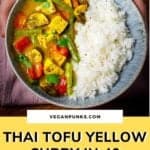
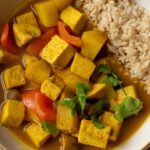
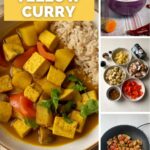
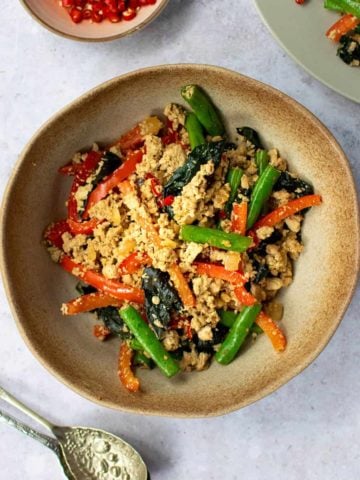
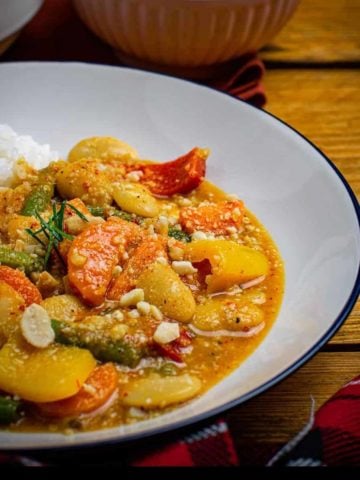
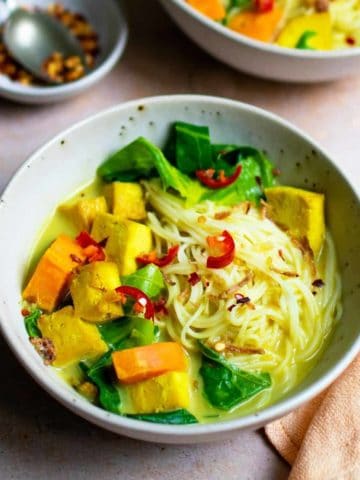
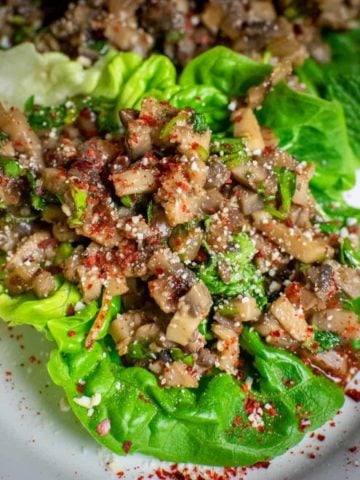
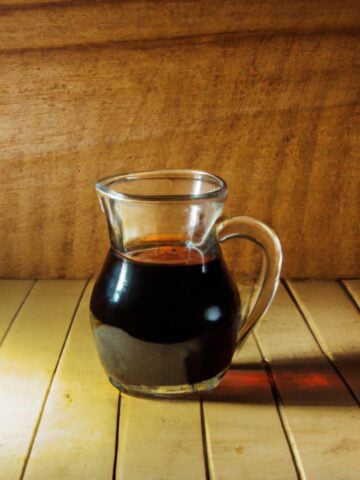
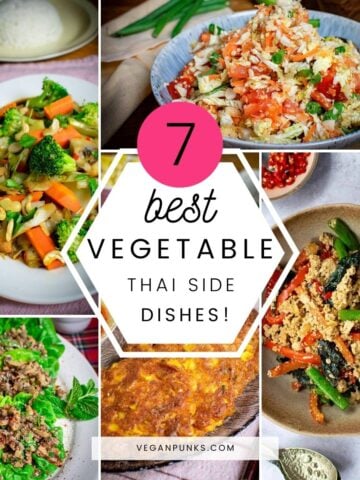
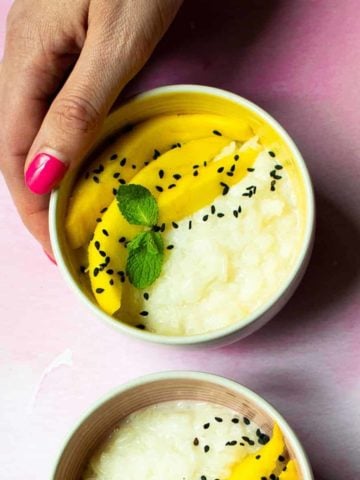
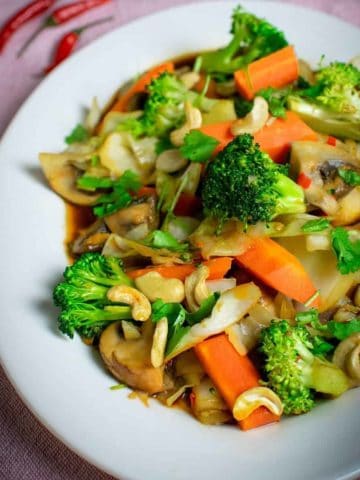
Comments
No Comments